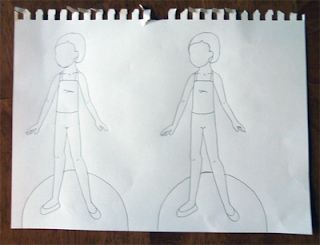Tracing a doll is one of the easiest methods for creating a paper doll and very low-tech. As a child, I created dolls using a window, a little sunlight, and some masking tape. It really doesn't get any easier than that! After I got a lightbox, it became indispensable. I still use the same lightbox 15 years later. The method for using a window versus a lightbox are the same with minor variations, which I will detail after the window method.
Method A: Using a window
Materials list:
Window & sunlight
Masking tape
Paper, pencil, eraser
Doll template
Pen, archival art pen preferred
Step 1:
Find a window that will fit your paper and remember you WILL get fingerprints on it! Moderate sunlight works best. Too much light can be as bad as too little. Attach your template to the window using a lightweight masking tape.
Step 2:
Next, tape your drawing paper over the template. Your paper should be heavy enough to draw on, but thin enough to see through. Standard printing paper works well. I like to use sketchbook paper. I like to fit as many templates as possible on one sheet so I tend to work on horizontal paper. Also, if using a base, I try to line up the bottom of the base with the edge of the paper. One less line to draw that way!
Step 3:
Trace your doll template. There's no need to trace every detail, so skip tracing the features of the face, etc. Trace the outline of the figure and the doll's base outfit. Trace enough of the doll so that creating clothing and tabs will be possible. As for tracing, try to be as accurate as possible. A better clothing template will make for a better fit later on, especially if you choose not to retouch/edit your doll digitally.
Below, there's an image of a completed template. In this case, I traced the outlines of the body, hair, and base, as well as the lines of the shoes, base clothing, and anatomy lines such as knees and collar bones.
In the final image below, I have two templates on my paper. My doll has a wide base and I could only fit two dolls per sheet. Each doll is different and the size of your drawing paper will determine the amount of templates per page. Create as many template sheets as you want for your completed doll.
Method B: Using a Lightbox
Materials list:
Masking tape
Paper, pencil, eraser
Doll template
Pen, archival art pen preferred
Lightbox
Basically, the process is the same when using a lightbox. One thing to keep in mind is paper size. Working on a 10x12 lightbox with 16x20 paper is just not going to work well…
Step 1:
Tape your doll template to the lightbox.
Step 2:
Tape your paper for tracing over the doll template.
Step 3:
Trace as accurately as possible. My lightbox has a dimmer switch so I can check the accuracy of my tracing. Reposition the paper on your lightbox as needed to trace out as many templates as you want.
There are a few advantages to using a lightbox:
1) Portability.
You can use a lightbox basically anywhere you can plug it in. My lightbox is 10x12 inches. Lightboxes come in a variety of sizes so you can choose the one that works best for you.
2) Work the Way You Want
I like to sit down to draw. Using the window method requires me to stand at a window with my arms raised is a sometimes awkward manner. With the lightbox, I can lay it flat on my lap and draw at the couch, or prop it up at an angle on a hard surface. There's a lot of flexibility available.
3) Consistent light
If you work at a window enough times, you'll realize that sunlight changes. Maybe a storm rolls in or a cloud passes the sun: it's perfect lighting one minute and then it isn't. A lighbox is always the same. Also, I've never had to replace the bulb in my lightbox and I've had it for 15 or so years. Sure, I don't use it every day, but that's still a great advantage.
4) Accuracy
Because drawing on the lightbox is a more natural drawing position for me, I find the accuracy of my tracing is a bit better.
 |
| Window method on the left, lightbox on the right |
Next time, the real fun begins. I'll discuss how I draw outfits & place tabs, as well as ideas for developing ideas and themes for your doll's wardrobe.








































